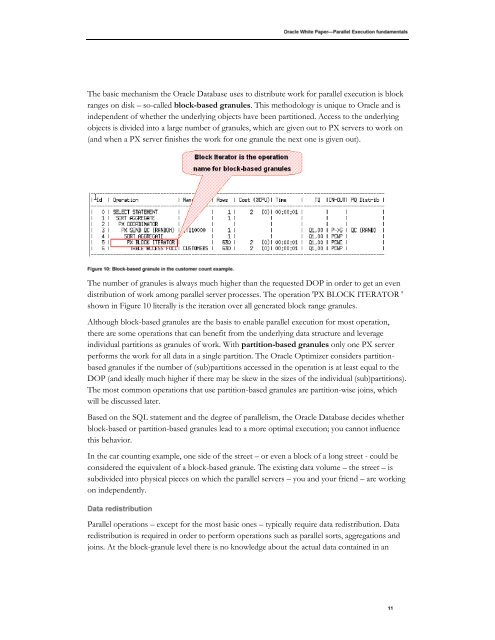Oracle Database Parallel Execution Fundamentals
Oracle Database Parallel Execution Fundamentals
Oracle Database Parallel Execution Fundamentals
Create successful ePaper yourself
Turn your PDF publications into a flip-book with our unique Google optimized e-Paper software.
The basic mechanism the <strong>Oracle</strong> <strong>Database</strong> uses to distribute work for parallel execution is block<br />
ranges on disk – so-called block-based granules. This methodology is unique to <strong>Oracle</strong> and is<br />
independent of whether the underlying objects have been partitioned. Access to the underlying<br />
objects is divided into a large number of granules, which are given out to PX servers to work on<br />
(and when a PX server finishes the work for one granule the next one is given out).<br />
The number of granules is always much higher than the requested DOP in order to get an even<br />
distribution of work among parallel server processes. The operation 'PX BLOCK ITERATOR '<br />
shown in Figure 10 literally is the iteration over all generated block range granules.<br />
Although block-based granules are the basis to enable parallel execution for most operation,<br />
there are some operations that can benefit from the underlying data structure and leverage<br />
individual partitions as granules of work. With partition-based granules only one PX server<br />
performs the work for all data in a single partition. The <strong>Oracle</strong> Optimizer considers partitionbased<br />
granules if the number of (sub)partitions accessed in the operation is at least equal to the<br />
DOP (and ideally much higher if there may be skew in the sizes of the individual (sub)partitions).<br />
The most common operations that use partition-based granules are partition-wise joins, which<br />
will be discussed later.<br />
Based on the SQL statement and the degree of parallelism, the <strong>Oracle</strong> <strong>Database</strong> decides whether<br />
block-based or partition-based granules lead to a more optimal execution; you cannot influence<br />
this behavior.<br />
In the car counting example, one side of the street – or even a block of a long street - could be<br />
considered the equivalent of a block-based granule. The existing data volume – the street – is<br />
subdivided into physical pieces on which the parallel servers – you and your friend – are working<br />
on independently.<br />
<strong>Parallel</strong> operations – except for the most basic ones – typically require data redistribution. Data<br />
redistribution is required in order to perform operations such as parallel sorts, aggregations and<br />
joins. At the block-granule level there is no knowledge about the actual data contained in an<br />
11

















